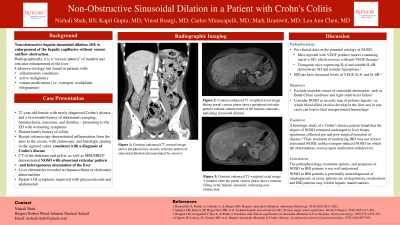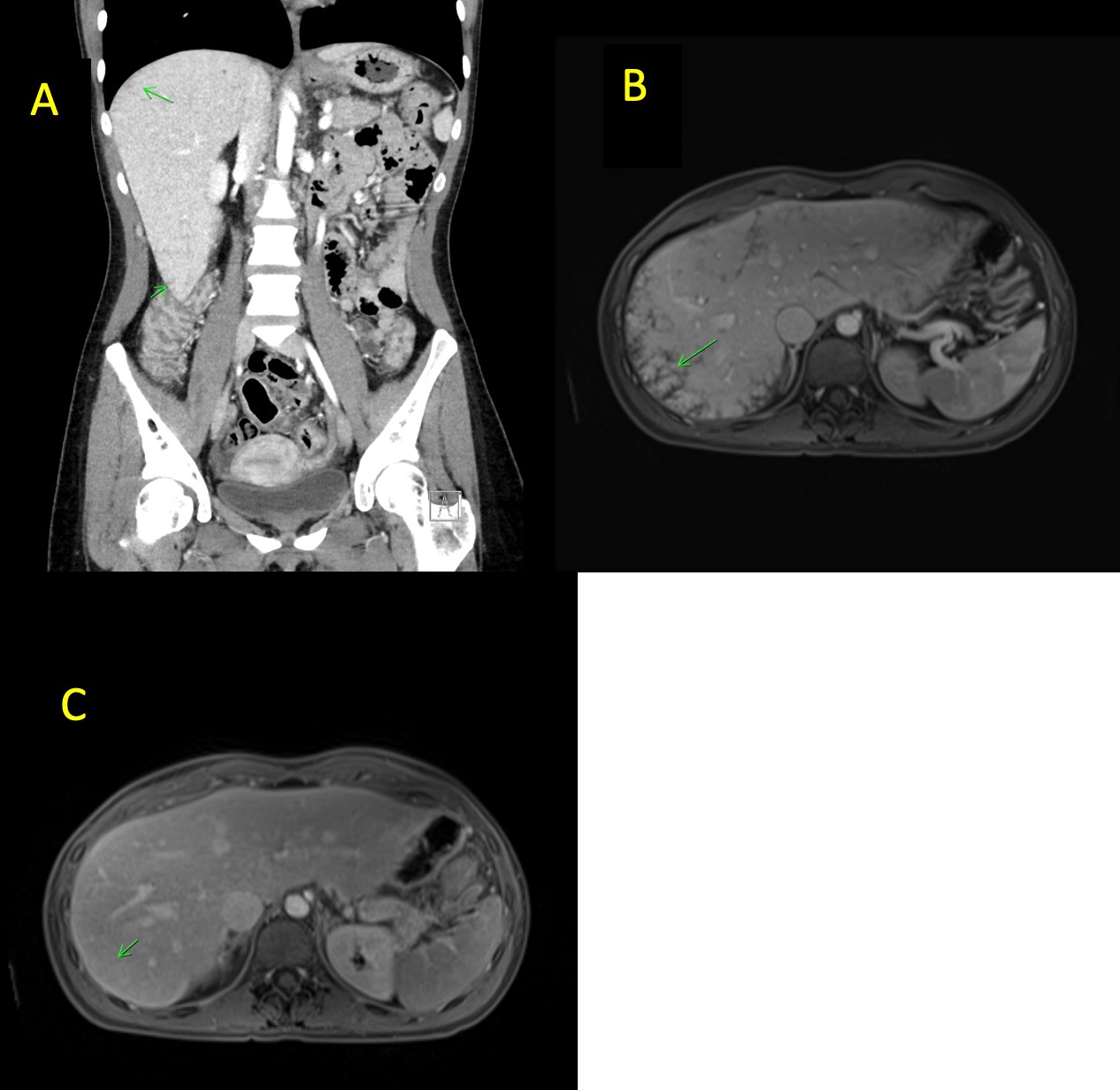Back


Poster Session B - Monday Morning
Category: IBD
B0434 - Non-Obstructive Sinusoidal Dilation in a Patient With Crohn's Colitis
Monday, October 24, 2022
10:00 AM – 12:00 PM ET
Location: Crown Ballroom

Has Audio
.jpg)
Nishali Shah, BS
Rutgers Robert Wood Johnson Medical School
New Brunswick, NJ
Presenting Author(s)
Nishali Shah, BS1, Kapil Gupta, MD2, Vinod Rustgi, MD1, Carlos Minacapelli, MD1, Mark Bramwit, MD1, Lea Ann Chen, MD1
1Rutgers Robert Wood Johnson Medical School, New Brunswick, NJ; 2Rutgers Robert Wood Johnson University Hospital- New Brunswick, New Brunswick, NJ
Introduction: Non-obstructive sinusoidal dilation (NOSD) is an enlargement of the hepatic capillaries without venous outflow obstruction. It is characterized by a "mosaic pattern" of mottled and reticular hepatic enhancement radiographically and by distended sinusoidal spaces most evident in Zone III histologically. While it has been associated with active malignancy, certain medications, and inflammatory conditions, an understudied association exists between NOSD and IBD.
Case Description/Methods: We present a 27-year-old female recently diagnosed with sigmoid-sparing Crohn’s colitis. Despite initiating mesalamine therapy, her symptoms progressed. A CT abdomen/pelvis noted the colitis, as well as heterogeneous attenuation of the liver (Fig 1a). MRI/MRCP identified abnormal reticular enhancement in the right hepatic lobe without blockage in venous outflow, consistent with NOSD (Fig 1b,1c). Liver chemistries revealed no hepatocellular or cholestatic abnormalities. The patient's IBD symptoms improved with the initiation of glucocorticoids and adalimumab, allowing for discharge to outpatient follow-up.
Discussion: While the etiology of NOSD is not well understood, pre-clinical evidence suggests that altered angiogenesis may play a role. Mice injected with vascular endothelial growth factor (VEGF) produce tumors containing massive NOSD, which reverse with anti-VEGF therapy.1 Additionally, mice overexpressing either IL-6 or IL-6 receptor demonstrate sinusoidal dilation and nodular hyperplasia.1 Interestingly, IBD patients also have increased levels of VEGF, IL-6, and IL-6 receptor, which may contribute to their risk of dysregulated angiogenesis and NOSD development.
There is still little research on the natural history of NOSD and its response to treatment of underlying comorbidities. A single-center study of a patient with Crohn’s disease found that the degree of NOSD remained unchanged in the patient when comparing liver biopsy specimens collected pre-and post-surgical resection of disease.2 Therefore, treatment of underlying IBD may not resolve associated NOSD, unlike estrogen-induced NOSD for which laboratory abnormalities are reversible upon medication withdrawal.

Disclosures:
Nishali Shah, BS1, Kapil Gupta, MD2, Vinod Rustgi, MD1, Carlos Minacapelli, MD1, Mark Bramwit, MD1, Lea Ann Chen, MD1. B0434 - Non-Obstructive Sinusoidal Dilation in a Patient With Crohn's Colitis, ACG 2022 Annual Scientific Meeting Abstracts. Charlotte, NC: American College of Gastroenterology.
1Rutgers Robert Wood Johnson Medical School, New Brunswick, NJ; 2Rutgers Robert Wood Johnson University Hospital- New Brunswick, New Brunswick, NJ
Introduction: Non-obstructive sinusoidal dilation (NOSD) is an enlargement of the hepatic capillaries without venous outflow obstruction. It is characterized by a "mosaic pattern" of mottled and reticular hepatic enhancement radiographically and by distended sinusoidal spaces most evident in Zone III histologically. While it has been associated with active malignancy, certain medications, and inflammatory conditions, an understudied association exists between NOSD and IBD.
Case Description/Methods: We present a 27-year-old female recently diagnosed with sigmoid-sparing Crohn’s colitis. Despite initiating mesalamine therapy, her symptoms progressed. A CT abdomen/pelvis noted the colitis, as well as heterogeneous attenuation of the liver (Fig 1a). MRI/MRCP identified abnormal reticular enhancement in the right hepatic lobe without blockage in venous outflow, consistent with NOSD (Fig 1b,1c). Liver chemistries revealed no hepatocellular or cholestatic abnormalities. The patient's IBD symptoms improved with the initiation of glucocorticoids and adalimumab, allowing for discharge to outpatient follow-up.
Discussion: While the etiology of NOSD is not well understood, pre-clinical evidence suggests that altered angiogenesis may play a role. Mice injected with vascular endothelial growth factor (VEGF) produce tumors containing massive NOSD, which reverse with anti-VEGF therapy.1 Additionally, mice overexpressing either IL-6 or IL-6 receptor demonstrate sinusoidal dilation and nodular hyperplasia.1 Interestingly, IBD patients also have increased levels of VEGF, IL-6, and IL-6 receptor, which may contribute to their risk of dysregulated angiogenesis and NOSD development.
There is still little research on the natural history of NOSD and its response to treatment of underlying comorbidities. A single-center study of a patient with Crohn’s disease found that the degree of NOSD remained unchanged in the patient when comparing liver biopsy specimens collected pre-and post-surgical resection of disease.2 Therefore, treatment of underlying IBD may not resolve associated NOSD, unlike estrogen-induced NOSD for which laboratory abnormalities are reversible upon medication withdrawal.
- Marzano C, et al. The significance of nonobstructive sinusoidal dilatation of the liver: Impaired portal perfusion or inflammatory reaction syndrome. Hepatology 2015. 956-963.
- Capron JP, et al. Hepatic sinusoidal dilatation in Crohn's disease. Scand J Gastroenterol 1978. 987-992.

Figure: A) Contrast enhanced CT coronal image shows peripheral low density reticular pattern of sinusoidal dilation. B) Contrast enhanced T1 weighted axial image during portal venous phase shows peripheral reticular pattern without enhancement of the hepatic sinusoids, indicating sinusoidal dilation. C) Contrast enhanced T1 weighted axial image 5 minutes after the portal venous phase shows filling in with contrast of the hepatic sinusoids, indicating non-obstruction.
Disclosures:
Nishali Shah indicated no relevant financial relationships.
Kapil Gupta indicated no relevant financial relationships.
Vinod Rustgi: Abbvie – Speakers Bureau. Gilead – Speakers Bureau.
Carlos Minacapelli indicated no relevant financial relationships.
Mark Bramwit indicated no relevant financial relationships.
Lea Ann Chen: Intrinsic Medicine – Consultant. Phatom – Advisory Committee/Board Member. PredictImmune – Consultant, Grant/Research Support.
Nishali Shah, BS1, Kapil Gupta, MD2, Vinod Rustgi, MD1, Carlos Minacapelli, MD1, Mark Bramwit, MD1, Lea Ann Chen, MD1. B0434 - Non-Obstructive Sinusoidal Dilation in a Patient With Crohn's Colitis, ACG 2022 Annual Scientific Meeting Abstracts. Charlotte, NC: American College of Gastroenterology.
